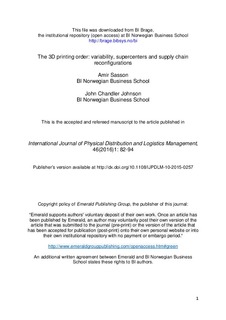| dc.contributor.author | Sasson, Amir | |
| dc.contributor.author | Johnson, John Chandler | |
| dc.date.accessioned | 2016-05-20T12:52:32Z | |
| dc.date.available | 2016-05-20T12:52:32Z | |
| dc.date.issued | 2016 | |
| dc.identifier.citation | International Journal of Physical Distribution and Logistics Management, 46(2016)1: 82-94 | nb_NO |
| dc.identifier.issn | 0960-0035 | |
| dc.identifier.issn | 1758-664x | |
| dc.identifier.uri | http://hdl.handle.net/11250/2389954 | |
| dc.description | This is the accepted and refereed manuscript to the article | nb_NO |
| dc.description.abstract | Purpose: Direct Digital Manufacturing (DDM) is conceived of as either disrupting the entire manufacturing economy or merely enabling novel production. Between these extremes, we introduce an alternative where DDM coexists with and complements traditional mass production. When multiple parts run across one manufacturing line, DDM can isolate variability associated with low volume part production and may be preferred to mass production despite being expensive. If DDM complements rather than cannibalizes mass production, this alters our understanding of who adopts DDM, the products built with DDM, and DDM’s long-term supply chain implications.
Design/methodology/approach: This invited article explores a DDM rollout scenario and qualitatively assesses potential supply chain reconfigurations.
Findings: Our analysis recognizes that existing manufacturers with heterogeneous bills-of-material may develop DDM capabilities to isolate disruptive, low-volume production from scalable mass production. Developing DDM competence and raw material scale advantages, these manufacturers become the locus of change in a manufacturing landscape increasingly characterized by multi-product DDM supercenters.
Originality/Value: Extant research largely focuses on two potential reasons for DDM adoption: cost-per-unit and time-to-delivery comparisons. We explore a third driver: DDM’s capacity to isolate manufacturing variability attributable to low volume parts. Relative to the extant literature, this suggests a different DDM rollout, different adopters, and a different supply chain configuration. We identify mass manufacturing variability reduction as the mechanism through which DDM may be adopted. This adoption trajectory would eventually enable a supply chain transition in which spare parts inventory migrates from finished goods at proprietary facilities to raw materials at generalized DDM supercenters. | nb_NO |
| dc.language.iso | eng | nb_NO |
| dc.publisher | Emerald | nb_NO |
| dc.title | The 3D printing order: variability, supercenters and supply chain reconfigurations | nb_NO |
| dc.type | Journal article | nb_NO |
| dc.type | Peer reviewed | nb_NO |
| dc.source.journal | International Journal of Physical Distribution and Logistics Management | nb_NO |
| dc.identifier.doi | http://dx.doi.org/10.1108/IJPDLM-10-2015-0257 | |
| dc.description.localcode | 1. Forfatterversjon | nb_NO |
